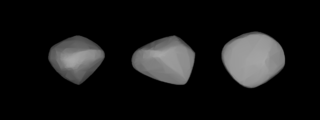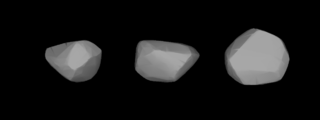Related Research Articles

Phocaea is a stony asteroid from the inner regions of the asteroid belt, approximately 75 kilometers in diameter. It is the parent body of the Phocaea family. Discovered by Jean Chacornac in 1853, it was named after the ancient Greek city of Phocaea.

Klymene is a large, dark Themistian asteroid that was discovered by J. C. Watson on September 13, 1868, and named after one of the many Clymenes in Greek mythology. It is orbiting the Sun with a period of 5.60 years and an eccentricity of 0.16. The orbital plane is inclined by 2.8° to the plane of the ecliptic. It is classified as a C-type asteroid, indicating it probably has a carbonaceous composition. The spectra indicates the presence of aqueous-altered minerals on the surface based upon a sharp feature at a wavelength of 3 μm, and, as of 2015, is the only member of the Themis family found to show this absorption.

165 Loreley is a main-belt asteroid that was discovered by C. H. F. Peters on August 9, 1876, in Clinton, New York and named after the Lorelei, a figure in German folklore.

175 Andromache is a main-belt asteroid that was discovered by Canadian-American astronomer J. C. Watson on October 1, 1877, and named after Andromache, wife of Hector during the Trojan War. Watson's telegram to Europe announcing the discovery became lost, and so notification did not arrive until several weeks later. As a result, another minor planet, later designated 176 Iduna, was initially assigned the number 175.

Elsa is a Massalia or background asteroid from the inner regions of the asteroid belt, approximately 44 kilometers in diameter. It was discovered on 7 February 1878, by Austrian astronomer Johann Palisa at the Austrian Naval Observatory in today's Croatia. The S-type asteroid has a very long rotation period of 80 hours and likely an elongated shape. The origin of its name is uncertain.

Nausikaa is a large main-belt S-type asteroid. It was discovered by Johann Palisa on February 17, 1879, at Pula, then in Austria, now in Croatia. The name derives from Nausicaä, a princess in Homer's Odyssey.

Prokne is a main-belt asteroid that was discovered by German-American astronomer C. H. F. Peters on March 21, 1879, in Clinton, New York, and named after Procne, the sister of Philomela in Greek mythology. Stellar occultations by Prokne have been observed twice, in 1984 from Italy and again in 1999 from Iowa.

Ampella is a Main belt asteroid that was discovered by Alphonse Borrelly on June 13, 1879. The name seems to be the feminine form of Ampelos, a satyr and good friend of Dionysus in Greek mythology. It could also derive from the Ampelose, a variety of hamadryad. It is an S-type asteroid.

225 Henrietta is a very large outer main-belt asteroid. It was discovered by Austrian astronomer Johann Palisa on April 19, 1882, in Vienna and named after Henrietta, wife of astronomer Pierre J. C. Janssen. The asteroid is orbiting at a distance of 3.39 AU from the Sun with a period of 6.24 years and an eccentricity (ovalness) of 0.26. The orbital plane is inclined at an angle of 20.9° to the plane of the ecliptic. 225 Henrietta belongs to Cybele group of asteroids and is probably in a 4:7 orbital resonance with the planet Jupiter.

Libussa is a Main belt asteroid that was discovered by C. H. F. Peters on December 22, 1886, in Clinton, New York and was named after Libussa, the legendary founder of Prague. It is classified as an S-type asteroid.

Polyxo is a main-belt asteroid that was discovered by A. Borrelly on March 31, 1891, in Marseilles. It is orbiting the Sun at a distance of 2.75 AU with a low orbital eccentricity (ovalness) of 0.04 and a period of 4.56 yr. The orbital plane is tilted at an angle of 4.36° to the plane of the ecliptic.
Gyptis, minor planet designation: 444 Gyptis, is a main-belt asteroid that was discovered by J. Coggia on March 31, 1899, in Marseilles. It is classified as a C-type asteroid and is probably composed of carbonaceous material. The spectra of the asteroid displays evidence of aqueous alteration.
674 Rachele is a minor planet orbiting the Sun. It was discovered by Wilhelm Lorenz on 28 October 1908 in Heidelberg, and was named by orbit computer Emilio Bianchi after his wife. This is classified as an S-type asteroid, indicating a stony composition.

679 Pax is a minor planet orbiting the Sun that was discovered by German astronomer August Kopff on January 28, 1909. It is named after Pax, a Roman goddess. It is orbiting the Sun with a period of 4.16 years and an eccentricity of 0.31.
758 Mancunia is a minor planet orbiting the Sun. It was discovered in 1912 from Johannesburg by H. E. Wood, a Mancunian. This object is orbiting at a distance of 3.19 AU with a period of 5.70 years and an eccentricity (ovalness) of 0.15. The orbital plane is inclined at an angle of 5.61° to the plane of the ecliptic.
790 Pretoria is a minor planet orbiting the Sun that was discovered by English astronomer Harry Edwin Wood on January 16, 1912. It is a member of the Cybele group located beyond the core of the main belt and named after Pretoria, the capital city of South Africa.
804 Hispania is a minor planet orbiting the Sun. It was discovered from Barcelona (Spain) on 20 March 1915 by Josep Comas Solá (1868–1937), the first asteroid to be discovered by a Spaniard.
914 Palisana, provisional designation 1919 FN, is a Phocaean asteroid from the inner regions of the asteroid belt, approximately 77 kilometers in diameter. It was discovered by German astronomer Max Wolf at Heidelberg Observatory on 4 July 1919.
980 Anacostia is a minor planet orbiting the Sun that was discovered by American astronomer George Henry Peters on 21 November 1921. The name recognizes the Anacostia River and an historic neighborhood of the same name in the city of Washington D.C.
3790 Raywilson, provisional designation 1937 UE, is a carbonaceous Themistian asteroid from the outer regions of the asteroid belt, approximately 12 kilometers in diameter. It was discovered on 26 October 1937, by astronomer Karl Reinmuth at the Heidelberg-Königstuhl State Observatory in Heidelberg, Germany. The C-type asteroid has a rotation period of 4.65 hours. It was named for English physicist Raymond Wilson.
References
- 1 2 "654 Zelinda (1908 BM)". JPL Small-Body Database . NASA/Jet Propulsion Laboratory . Retrieved 7 May 2016.
- 1 2 3 Carry, B. (December 2012), "Density of asteroids", Planetary and Space Science, vol. 73, pp. 98–118, arXiv: 1203.4336 , Bibcode:2012P&SS...73...98C, doi:10.1016/j.pss.2012.03.009. See Table 1.
- ↑ Ostro, S. J.; et al. (October 1991), "Asteroid radar astrometry", Astronomical Journal, vol. 102, pp. 1490–1502, Bibcode:1991AJ....102.1490O, doi:10.1086/115975.
- ↑ Marchis, F.; et al. (November 2006), "Shape, size and multiplicity of main-belt asteroids. I. Keck Adaptive Optics survey", Icarus, vol. 185, no. 1, pp. 39–63, Bibcode:2006Icar..185...39M, doi:10.1016/j.icarus.2006.06.001, PMC 2600456 , PMID 19081813 , retrieved 27 March 2013.